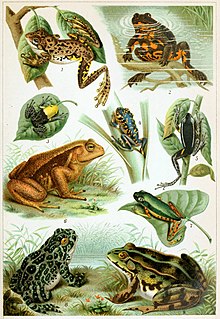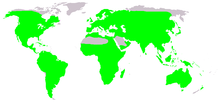
Back Жабы Byelorussian Granota Catalan Шапасем CV Rana Spanish Besé FON Grenouille French Bese GUW ꯍꯉꯣꯢ MNI Kikker Dutch Froskar NN
| Frogs | |
|---|---|

| |
| Various types of frogs. | |
| Scientific classification | |
| Domain: | Eukaryota |
| Kingdom: | Animalia |
| Phylum: | Chordata |
| Class: | Amphibia |
| Clade: | Salientia |
| Order: | Anura |
| Suborders | |

| |
| Native distribution of frogs (in green) | |
Frogs are amphibians and vertebrates of the order Anura. There is not much difference between frogs and toads, and they are not classified separately. This is because the toad lifestyle, with its dry, rough, skin, is an adaptation to living in drier habitats. The toad form has evolved a number of times independently, an example of convergent evolution.[1]
Frogs can live on land and in fresh water. They cannot survive in salt water. Their development is by metamorphosis. They usually hatch as tadpoles from eggs, which are laid by a female frog. The eggs are called frogspawn. Tadpoles have tails and gills. The next stage, the "froglet," develops lungs to breathe air instead of gills, but still have tails. The fully grown frog has long legs and no tail.
Adult frogs can jump with their legs. They have long tongues that they use to catch bugs. They make a sound called a croak. Some species live in trees, and some types of frog are protected by being poisonous. Frogs live all over the world. If a foreign species of frogs is introduced to another country, the local ecosystem might be affected.
Frog legs are sometimes eaten as food in France, China, and the Midwest of the United States. The killing of frogs might have an effect on the ecosystem. For example, frogs eat mosquitoes. If frogs are killed, then there are fewer frogs to eat mosquitoes, so more and more mosquitoes are born. Therefore, in these areas, there are more diseases that mosquitoes carry, because there are more mosquitoes. However, for this to apply, frogs would have to be a major predator of mosquitoes. This would only rarely be the case.
Frogs are members of the class Lissamphibia, the only class of amphibians which has survived to the present day.[2]
- ↑ Zweifel, Richard G; Cogger H.G. & Kirshner D. 1998. Encyclopedia of reptiles and amphibians. San Diego: Academic Press. pp. 91–92. ISBN 0-12-178560-2
- ↑ Carroll, Robert 2009. The rise of amphibians: 360 milion years of evolution. Johns Hopkins University Press, Baltimore. Chapter 10: The ancestry of frogs. ISBN 978-0-8018-9140-3